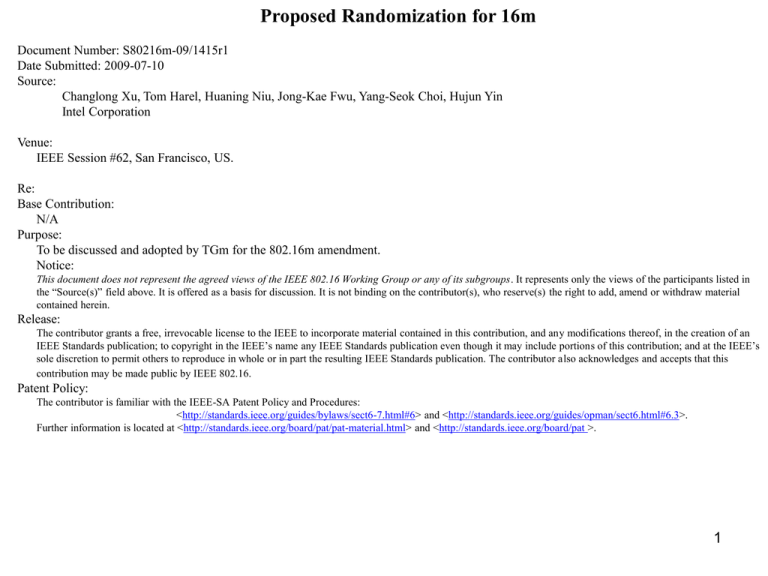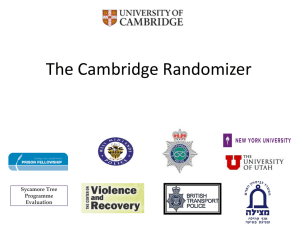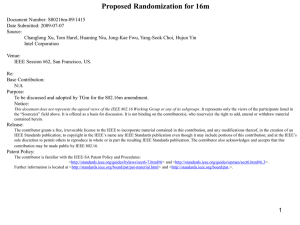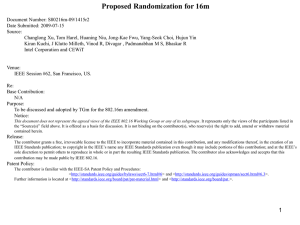Proposed Randomization for 16m
advertisement

Proposed Randomization for 16m Document Number: S80216m-09/1415r1 Date Submitted: 2009-07-10 Source: Changlong Xu, Tom Harel, Huaning Niu, Jong-Kae Fwu, Yang-Seok Choi, Hujun Yin Intel Corporation Venue: IEEE Session #62, San Francisco, US. Re: Base Contribution: N/A Purpose: To be discussed and adopted by TGm for the 802.16m amendment. Notice: This document does not represent the agreed views of the IEEE 802.16 Working Group or any of its subgroups. It represents only the views of the participants listed in the “Source(s)” field above. It is offered as a basis for discussion. It is not binding on the contributor(s), who reserve(s) the right to add, amend or withdraw material contained herein. Release: The contributor grants a free, irrevocable license to the IEEE to incorporate material contained in this contribution, and any modifications thereof, in the creation of an IEEE Standards publication; to copyright in the IEEE’s name any IEEE Standards publication even though it may include portions of this contribution; and at the IEEE’s sole discretion to permit others to reproduce in whole or in part the resulting IEEE Standards publication. The contributor also acknowledges and accepts that this contribution may be made public by IEEE 802.16. Patent Policy: The contributor is familiar with the IEEE-SA Patent Policy and Procedures: <http://standards.ieee.org/guides/bylaws/sect6-7.html#6> and <http://standards.ieee.org/guides/opman/sect6.html#6.3>. Further information is located at <http://standards.ieee.org/board/pat/pat-material.html> and <http://standards.ieee.org/board/pat >. 1 Outline • Data randomization and subcarrier randomization in 16e • Data randomization in current AWD text • Proposed randomization • Performance comparison • Summary 2 1. Data randomizer and subcarrier randomizer in 16e Subcarrier randomizer Data to transmit in PHY burst Randomizer (8.4.9.1) FEC (8.4.9.2) Bit-interleaver (8.4.9.3) Repetition (8.4.9.5) Modulation (8.4.9.4) Mapping to OFDMA subchannels Figure 1 Channel coding process for regular and repetition coding transmission 3 1.1 Data randomizer LSB MSB 1 2 3 4 5 6 7 8 9 10 11 12 13 14 15 data out data in • Generator polynomial 1 + x14+x15 • Initial Vector [LSB] 0 1 1 0 1 1 1 0 0 0 1 0 1 0 1 [MSB] –Each FEC block • Function Avoiding long runs of bit that are bad for modulator. 4 1.2 Subcarrier Randomizer LSB 1 MSB 2 3 4 5 6 7 8 9 10 11 wk • • Generator polynomial 1 + x9+ x11 Initial Vector - Each sub-frame – b0 .. b4 5 LSB of IDcell – b5,b6 the segment number + 1 – b7..b10 0b1111 for downlink; four least significant bits of the Frame number in the uplink. • Function – Randomize the interference between different cells – Avoid exact repetition of QAM symbol. Repetition within an OFDM symbol causes high PAPR and repetitive interference. 5 2. Data randomization in current AWD text Subcarrier randomizer Work well? Burst CRC encoder Data Randomizer Burst partition FEC block CRC encoder FEC encoder Bit selection & Repetition Collection Modulation Figure 2 Channel coding procedure in current AWD text Problem: Data Randomize is same as that in 16e. It is easy to consider the subcarrier randomizer in 16e. Reusing subcarrier randomizer in 16e do not work: 1. Only 7-bit in initial vector for IDcell indicator. 10-bit IDcell is used in 16m. 2. Different users in same cell has same initial vector may cause interference each other for MU-MIMO case. 6 3. Proposed randomization Move randomizer to the position before the modulation Burst CRC encoder Data Randomizer Burst partition FEC block CRC encoder FEC encoder Bit selection & Repetition Collection Modulation • Low complexity (one randomizer instead of the two randomizer in • Good performance – Randomize the interference between adjacent cell – Avoid exact repetition of QAM symbol – Avoiding long runs of bit 7 Parameters for proposed randomization LSB 1 Data in MSB 2 3 4 5 6 . . . 18 19 20 21 22 23 Data out • Generator polynomial 1 + x18+x23 • Initial Vector b13 … b22 IDcell b12 1 (avoid all zero initial state) b0 … b11 STID Reset the seed for each burst 8 4. Performance comparison -Scenario All zero’s sequence for padding FEC encoder Modulation Case 1: Without Randomization All zero’s sequence for padding Data Randomizati on FEC encoder Modulation IFFT Case 2: Current AWD All zero’s sequence for padding Data Randomizati on FEC encoder Modulation Subcarrier randomizat ion IFFT Case 3: 16e solution All zero’s sequence for padding FEC encoder Proposed randomizat ion Modulation Case 4: Proposed solution IFFT 9 4.1 CDF for average power of modulator • Assumption – – – – 1/3 CTC, 64QAM All zero’s sequence source (padding) 2^14 symbols for randomizer in AWD 2^23/6 symbols for proposed randomizer • Results – – Always maximum power without randomizer Both of proposed randomizer and randomizer in AWD can mitigate the high power of modulator caused by long run of 0’s or 1’s 10 4.2 CDF for correlation of two adjacent cells • Assumption – – – – First cell ID 0100000000 Second cell ID 0010000000 1024 IFFT All zero’s sequence source • Results – The correlation results of proposed randomizer is less than 10% of 16e solution – 16e Solution does not work 11 – The proposed randomizer works well 5. Summary • Proposed a new randomizer instead of the original one in current AWD • Merit of the proposed randomizer – Low complexity (one randomizer instead of the two randomizer in 16e) – Good performance • Randomize the interference between adjacent cell • Avoid exact repetition of QAM symbol • Avoiding long runs of bit 12



